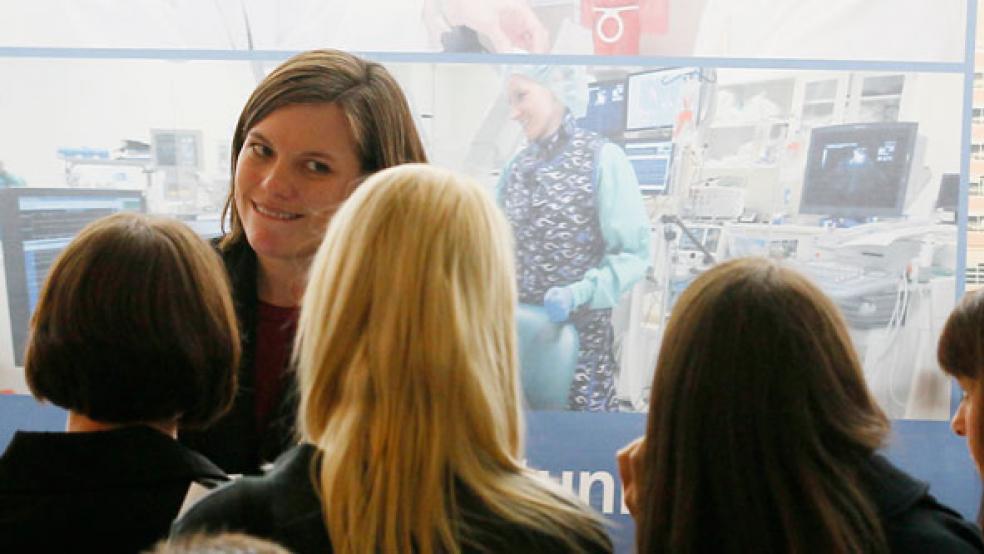
The Obama administration must convince 2.7 million Millennials to buy health insurance, or the new government exchanges being set up to provide coverage could prove to be a bust.
Because these younger Americans are usually healthy and rarely rack up huge medical bills, their monthly premiums would make it cheaper for the exchanges to affordably insure 4.3 million other Americans. The government has scrounged up $1.25 billion to market Obamacare—a must-win campaign that could make or break the 2010 law to expand coverage.
It’s a gamble on a generation raised by reality TV, fed with Lunchables, stuck with student loans, and addicted to the Internet. At stake is medical treatment for millions of Americans, the outcome of the 2014 congressional election, and President Obama’s legacy.
"Whatever happened in the past 3-1/2 years, this is the most important moment now because we're no longer dealing in abstraction,” Obama senior adviser David Simas, who led opinion research for the president’s 2012 campaign, told Reuters this month.
Congressional Republicans are betting on a chaotic disaster ahead of next year’s political races, while the administration and its private sector partners are scrambling to begin enrolling 18 to 35 year-olds in October. Simply opening the exchanges within the next five months could be an obstacle to the marketing campaign.
The Government Accountability Office said last week that the administration has been slow to figure out government subsidies based on income levels to offset some of the price of insurance. It still has to vet the health plans being offered. And the GAO noted that it has yet to fully train the “navigators” who will help people enroll in exchanges that the federal government plans to operate in 34 states.
The latest Census figures indicate that there are 19.1 million uninsured Americans in this age bracket, but that number steadily shrinks when other factors are considered.
Out of that total, about 6 million have incomes so close to the poverty line that they would qualify for Medicaid. That leaves about 9 million with incomes below $45,960 who would receive government subsidies under Obamacare to offset the cost of purchasing insurance through an exchange.
What further complicates all of this is that Obamacare provides many 18 to 35 year-olds with options besides the exchanges.
They could forgo coverage and pay a relatively modest tax penalty next year of no more than 1 percent of their income. Or, they could buy theoretically less expensive “catastrophic” coverage that is not part of the exchange risk pool. Or, they could remain on their parents’ health insurance plan until the age of 26.
These are all “really great” choices for young adults, said Adrianna McIntyre, a graduate student in public health at the University of Michigan who co-founded Project Millennial to analyze Obamacare.
But McIntyre receives her insurance via her parents’ coverage and cautioned, “I don’t think people are going to be sitting there and thinking for the good of the country, maybe I should enroll in the exchange, instead of staying on my parents’ plan.”
If you exclude Millennials with children—who would likely face stiff medical bills—and those who can stay on their parents’ coverage, the number of “eligible” young adults for the exchanges drops to 4 million, according to research by McIntyre and Josh Fangmeier, a consultant for the Center for Healthcare Research & Transformation in Ann Arbor, MI.
A target group as low as 4 million means the Obama administration must convince 67.5 percent of them to buy insurance from an exchange.
According to a poll released last week by the Kaiser Family Foundation, more than 71 percent of young adults said it was “very important to them personally” to have health insurance.
That’s an encouraging sign, said Jen Mishory, deputy director of the group Young Invincibles, who added that “basic literacy” about how insurance works with deductibles and co-pays is low.
“There is a significant number of people for whom this will be the first access to coverage,” said Mishory, whose organization is training people to talk about Obamacare options for young adults.
But even if Millennials understand the benefits of having health coverage, price will be a major factor in determining whether they enroll and early estimates are giving a sense of the likely costs and the possible rate shock.
Actuaries at the consulting firm Oliver Wyman projected earlier this year that a young adult earning $33,510 would currently pay about $2,400 in premiums for health insurance. They estimated that the cost would jump under an Obamacare exchange by $783 to $3,183 a year, or about 9.5 percent of their income.
That estimate received a reality check last month from Covered California, the exchange in that state. It received premium estimates for the Obamacare “silver” plan that would cost $2,532 a year. That is a slight $132 increase at the income level.
But for those with incomes just too high to qualify for Medicaid—$16,755—the exchange would offer a lot in savings to the status quo. Government subsidies would reduce the annual premium costs to just $528, a savings of almost $1,900 from the current costs.
Polling by the conservative American Action Forum indicates that the key will involve keeping rate shock below 20 percent. If premium costs increase by that much, 35 percent of those surveyed with insurance said they would drop their coverage.
This suggests that the key to getting Millennials to enroll will be keeping any price hikes below 20 percent.
“The economics lesson is simple,” said Douglas Holtz-Eakin, president of the American Action Forum, in a YouTube video posted by the group. “Consumers have a price point. And when young Americans see their premiums rise, more and more will stop buying.”




